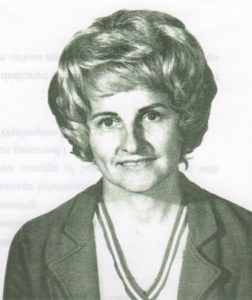EARLY CHILDHOOD SAFETY EDUCATION
Sabbatical Report – 1971 – by
Duane R. Johnson, Associate Professor
Department of Industry & Technology
Northern Illinois University
SHARINGS publication – 1973
Elementary School Section
NATIONAL SAFETY COUNCIL

This side contains excerpts from the report.
Purpose: To investigate current safety early childhood education programs and to work toward the development of a conceptual approach that might supersede fragmentary safety education programs.
This side contains Chlad’s comments.
The development of the comprehensive Safety Town curriculum – in 1965 – has been the foundation to a conceptual approach for safety education programs.
1. Programs ranged from – no special effort – to well-coordinated. Plans to formulate behaviorally oriented programs were found in Illinois and Maryland, although funding restricted those programs only to traffic safety orientation.
1. Don LaFond, Illinois Department of Education attended Chlad’s 8-hour seminar in 1970. “Plan to include your type of approach in curriculum.” Later moved to Maryland Department of Education. Used similar concept to develop materials.
2. Serious attention not given to safety education concerns. Response from Sesame Street personnel did not foresee when safety education would be of special concern to them.
2. Chlad was the first safety education consultant for – Sesame Street – in 1979. She conducted an 8-hour seminar for their Research and Development officials, mainly on educational aspects.
3. Teachers generally have no special preparation in safety. Told safety is “common sense” written and verbal pronouncements, intended to restrain risky behavior.
3. Effective “teaching techniques” were explicitly detailed in our curriculum manuals. Emphasis on “Child development as it relates to safety capabilities.”
4. Programs need to incorporate an education facet to help parents recognize their child’s needs for protection, recognition and their capabilities to perceive and react.
*4. A daily 15-minute “parent/child session” was introduced in 1965 by Chlad. A review of the lessons allowed parents to hear exactly what was taught.
5. Curricula should be analyzed to identify aspects where behavior has possibilities of personal injury. Feasible countermeasures should be adopted.
5. Areas as physical and mental skills, spontaneous behavior, perceptual limitations, short attention span, limited in making decisions, language and vocabulary development were incorporated in our manuals.
(This 4-page Sabbatical Report is available upon request.)
(See National Safety Town website – tabs – Manuals, Parent Guides, and 2016 Events for details.)
*4. A “parent session” also introduced in 1965 – where parents attended 1-hour – while children were in Safety Town classes.
“I sincerely hope this information will provide a better understanding of the lack of information and materials that was not available during those early years. That is why we encountered so many “challenges” to prove the effectiveness of Safety Town – and the importance of preschool/early childhood safety education.” – Dorothy Chlad

May 10, 1970 – Dorothy Chlad was told to contact her Congressman William Minshall regarding obtaining funds for local communities and need for national office to assist local communities. In 1972 – he recommended – National Highway Traffic Safety Administration (NHTSA.) She arranged a meeting. Results follow:
July 12, 1972 – To: Dorothy Chlad, From: LeRoy W. Dunn Ph.D.
I am interested in your safety towns and the philosophy behind their operation.
Looking forward to our meeting – regarding evaluation procedures relative to safety towns. The National Highway Traffic Safety Administration and the Federal Highway Administration have combined their efforts to identify these procedures.
May 20, 1977 – To: Dorothy Chlad From: LeRoy W. Dunn Ph.D.
I am impressed with the growth of safety towns across the nation.
The Federal Highway Administration has primary responsibility in this matter – and – a moratorium on funding was declared several years ago. It was decided that – a need existed for effective evaluation of safety towns. THE NEED STILL EXISTS TODAY.
Put together a conference at NSTC for safety town and officials representing the national, state, and local governments.
August 30, 1977 – To: Dorothy Chlad From: LeRoy W. Dunn Ph.D.
Your presentation on safety town was most informative – and – as usual enthusiastic. My staff and I were most impressed with the activities and programs you are conducting.
As we have discussed in the past, there is a need for evaluation of safety town as a pedestrian accident countermeasure. We are interested in your ideas on this subject.
January 20, 1979 – To: Dr LeRoy Dunn From: Dorothy Chlad
Chlad sent necessary information under guidance of Dr. Joseph Coleman – during a 2-year period – based on NSTC curriculum.
UNFORTUNATELY, the safety town they visited/evaluated was teaching motorcycle safety to 5-year olds? Chlad response was “that is not in our curriculum.” Dunn required a list of safety towns that used NSTC curriculum – IF NOT – a letter would be sent to each Governor’s Highway Safety Representative and police department – NOT TO BE INVOLVED WITH SAFETY TOWN.
Chlad quickly prepared and sent Dunn a list. All requirements were met and approved – and – 402 FUNDING BECAME AVAILABLE which has benefitted many communities through the country.
Excerpts from correspondence – Le Roy W. Dunn, Ph.D. Chief, Driver/Pedestrian Education Division, Traffic Safety Programs
THE HISTORY of SAFETY TOWNS
and the
CONTROVERSY THAT SURROUNDS THEM!

“Since 1963 – the biggest cheerleader for Safety Towns is Dorothy Chlad.”
Excerpts from:
Are Safety Towns Right For Your Community?
CHILDHOOD INJURY PREVENTION QUARTERLY-FALL 1992
by Susan Crites Price
Safety Towns vary greatly – in cost, curriculum, and ages of children targeted. Because the quality of the programs also varies, some critics dismiss them as not the most effective or cost-efficient way to teach children safety. The ones that are done right – can prevent accidents – reduce injuries and build lifelong safety awareness in children and parents
Chlad says – since most of a person’s intellectual development occurs before age 3 – safety awareness should be started before children enter school – even if the youngsters are not yet developmentally ready to learn complex tasks – such as safe street crossing.
Some traffic safety experts question that teaching street crossing before children are developmentally ready. Children may get a false sense of security when the “traffic” they experience is – toy cars or trikes. Parents fear – and assume – their children can safely cross the streets after the training.
Chlad takes issue with both assumptions. We introduce numerals before we teach children to add – and – letters before we teaching words. We have to INTRODUCE safety education even before children are developmentally and emotionally capable of understanding traffic. Realism is built into the second week of Safety Town when the children and teen instructors are taken – by a police officer – to practice crossing a real street.
A research stated “many activities are fun and model traffic layouts are cute and lavish – but – a half hour of driving miniature cars and crossing pretend streets has been shown to be ineffective in changing children’s street crossing behavior”.
Chlad stated – does a half hour of ANY instruction really change behavior? It INTRODUCES information that must be followed up with appropriate and constant additional instruction.
Some complain that – Safety Towns – will be thought of as a “silver bullet” . Can a brief, one-time course be an excuse for schools not to have ongoing safety programs or for parents to think home teaching is unnecessary?
Chlad was “stunned” wtih that reaction! “How would anyone make that conclusion?” Safety Town is the – INTRODUCTION – which is Phase 1 – followed by Phase 2 – and Phase 3 – plus – parent child session and special parent sessions – plus – continued school instruction and parent/community events.
Because there has not been much evaluation and since there is no safeguard that what is taught it every Safety Town is age-appropriate – or – even correct safety information, some experts remain cautious about – Safety Town.
Jeffrey Diver, Field Director of – National SAFE KIDS – campaign said “This is a problem that need not arise. By providing hands-on experience, Safety Towns are a great way to educate children about pedestrian safety – and – other safety issues. But they should never be considered a replacement for a multifacted injury prevention program”.
Chlad stated again – Safety Town is a program that INTRODUCES safety awareness and procedures. Many injuries have been prevented as a result of children and parents who participated in the program. (See example attached)
“We will NEVER know how many accidents, Safety Town and other programs prevented! Every time a child – stops their feet at the curb – wears a helmet – does not play with matches IS A PREVENTABLE ACCIDENT!” says Chlad.
